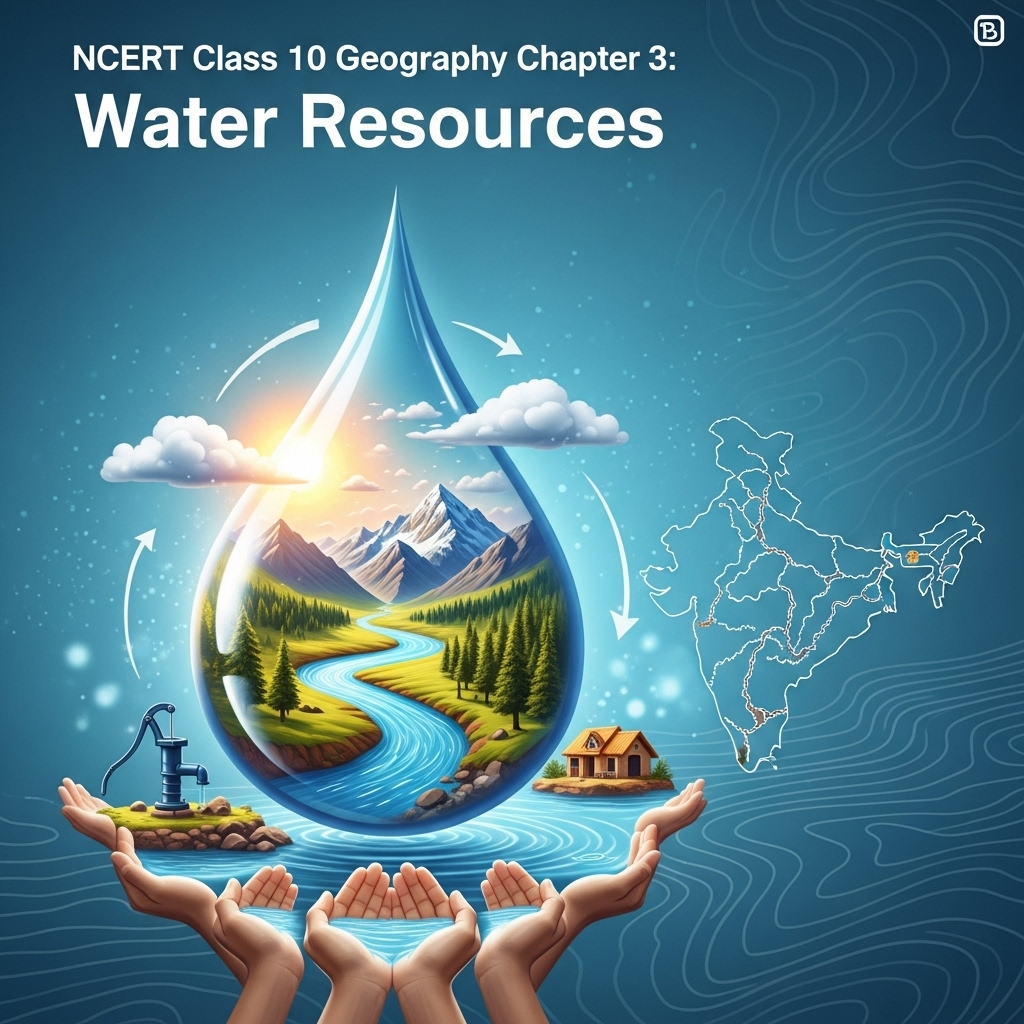Complete Solutions and Summary of Water Resources – NCERT Class 10, Geography, Chapter 3 – Summary, Questions, Answers, Extra Questions
Detailed summary and explanation of Chapter 3 ‘Water Resources’ covering the importance of water, water scarcity, water conservation, rainwater harvesting, multipurpose river projects, dams, irrigation, and water dispute issues with all question answers, activities, and extra questions from NCERT Class X Geography.
Updated: 2 months ago
Categories: NCERT, Class X, Geography, Summary, Extra Questions, Water Resources, Water Conservation, Irrigation, Dams, Rainwater Harvesting, Chapter 3

Water Resources
Chapter 3: Geography - Complete Study Guide | NCERT Class 10 Notes & Questions 2025
Comprehensive Chapter Summary - Water Resources Class 10 NCERT
Overview
- Chapter Purpose: Explains water as renewable resource via hydrological cycle; 3/4 Earth water-covered but freshwater scarce. Scarcity due to over-exploitation, unequal access, population growth. By 2025, 2 billion in absolute scarcity. Figure 3.1: Water Scarcity images. Focus: Conservation, management for health, food security, ecosystems. Key Insight: Scarcity not just low rain but misuse; urban examples. Jal Jeevan Mission (JJM): 55 lpcd potable water to rural households by ensuring tap functionality (Economic Survey 2020-21).
- Water Scarcity and Need for Conservation: Abundance misleading; scarcity from population, over-use for food, industry, urban lifestyles. Irrigation largest consumer; over-exploitation lowers groundwater. Industrialization/urbanization pressure freshwater; cities over-pump. Atal Bhujal Yojana: Behavioral change in 7 states for conservation.
- Expanded Relevance 2025: Climate change worsens scarcity; focus on pollution, floods. Update: Annual Report Ministry Jal Shakti 2022-23.
- Exam Tip: Link scarcity causes to examples; use Figure 3.4 for maps; know projects, harvesting methods.
- Broader Implications: Water vital for life; mismanagement causes ecological crisis, health hazards.
Multi-Purpose River Projects and Integrated Water Resources Management
- Ancient Hydraulic Structures: Dams, lakes, canals from ancient times (e.g., Sringaverapura flood channeling 1st century B.C.; Chandragupta Maurya systems; Bhopal Lake 11th century; Hauz Khas tank 14th century). Modern India continues with dams for irrigation, power, flood control, etc. Figure 3.2: Hirakud Dam. Dams: Barriers creating reservoirs; classified by structure (timber, embankment, masonry), height (low, medium, high).
- Role and Opposition: Nehru's 'temples of modern India' for development. Integrate agriculture/industry. But opposition: Affect natural flow, sedimentation, habitat loss, migration issues, trigger floods, earthquakes, diseases, salinization. Bhadu Song: Damodar floods. PM Krishi Sinchayee Yojana: Irrigation access, efficiency ('per drop more crop').
- Sardar Sarovar Dam: Narmada River; covers 4 states; irrigates drought-prone areas (18.45 lakh ha Gujarat, 2.46 lakh ha Rajasthan, 37,500 ha Maharashtra).
- Inter-State Disputes: E.g., Krishna-Godavari (Karnataka/AP objections to Maharashtra's Koyna diversion).
- Map: Figure: India Major Rivers and Dams.
Rainwater Harvesting
- Traditional Methods: Viable alternative; ancient knowledge of regimes, soils. Hills: 'Guls'/'Kuls' (Western Himalayas). Floodplains: Inundation channels (Bengal). Arid: 'Khadins' (Jaisalmer), 'Johads' (Rajasthan). Tankas: Underground tanks Rajasthan (e.g., Phalodi 6.1m deep); store 'palar pani' purest. Rooftop: Common Rajasthan; collect post-first rain.
- Modern Adaptations: Figure 3.3: Rooftop via hand pump/abandoned dugwell. Tamil Nadu: Compulsory rooftop. Meghalaya: Shillong rooftop despite high rain nearby (Cherrapunjee); 15-25% household water. Gendathur (Mysuru): 200 households collect 50,000 litres/house annually. Figure 3.4: Are You a Water Harvester? Figure 3.5: Traditional Kaza village tank. Figure 3.6: Thar rooftop to underground tanka.
- Bamboo Drip Irrigation: Meghalaya 200-year system; bamboo pipes tap springs, 18-20 litres enter, reduce to 20-80 drops/minute at plant. Figures 3.7: Pictures 1-6 showing system.
Floods
- Causes and Impacts: Heavy rain, sedimentation, poor drainage. Devastate life/property, soil erosion, land degradation. Figure: Flood-prone areas map.
- Basic Safety Precautions: Info to others, emergency kit, elevated grounds, avoid water/electrics/animals, etc.
SEO Note: Why This Guide?
Top-ranked for 'Water Resources Class 10 notes 2025'—free, with 60 Q&A from PDF, quizzes. Integrates conservation insights.
Key Themes
- Scarcity Variations: Quantitative (over-use) vs qualitative (pollution).
- Projects Details: Pros/cons, examples. Figure: Map.
- Harvesting Links: Traditional to modern for sustainability.
- Critical Thinking: Why dams opposed? How harvesting helps? Pollution impacts.
Cases for Exams
Use map for dams/rivers; discuss scarcity examples; analyze JJM objectives.
Exercises Summary
- Focus: Expanded to 60 Q&A from PDF: 20 short (2M), 20 medium (4M), 20 long (8M) based on NCERT exercises + similar.
- Project Idea: List disputes; info on pollution; enact dispute scene.
Group Discussions
No forum posts available.


